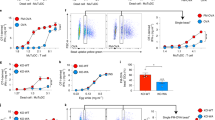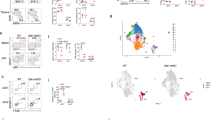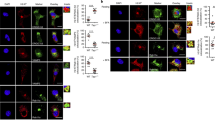Abstract
CD8α+ dendritic cells (DCs) are specialized at cross-presenting extracellular antigens on major histocompatibility complex (MHC) class I molecules to initiate cytotoxic T lymphocyte (CTL) responses; however, details of the mechanisms that regulate cross-presentation remain unknown. We found lower expression of the lectin family member Siglec-G in CD8α+ DCs, and Siglec-G deficient (Siglecg−/−) mice generated more antigen-specific CTLs to inhibit intracellular bacterial infection and tumor growth. MHC class I–peptide complexes were more abundant on Siglecg−/− CD8α+ DCs than on Siglecg+/+ CD8α+ DCs. Mechanistically, phagosome-expressed Siglec-G recruited the phosphatase SHP-1, which dephosphorylated the NADPH oxidase component p47phox and inhibited the activation of NOX2 on phagosomes. This resulted in excessive hydrolysis of exogenous antigens, which led to diminished formation of MHC class I–peptide complexes for cross-presentation. Therefore, Siglec-G inhibited DC cross-presentation by impairing such complex formation, and our results add insight into the regulation of cross-presentation in adaptive immunity.
This is a preview of subscription content, access via your institution
Access options
Subscribe to this journal
Receive 12 print issues and online access
$209.00 per year
only $17.42 per issue
Buy this article
- Purchase on Springer Link
- Instant access to full article PDF
Prices may be subject to local taxes which are calculated during checkout







Similar content being viewed by others
Accession codes
References
Bevan, M.J. Cross-priming for a secondary cytotoxic response to minor H antigens with H-2 congenic cells which do not cross-react in the cytotoxic assay. J. Exp. Med. 143, 1283–1288 (1976).
Joffre, O.P., Segura, E., Savina, A. & Amigorena, S. Cross-presentation by dendritic cells. Nat. Rev. Immunol. 12, 557–569 (2012).
den Haan, J.M., Lehar, S.M. & Bevan, M.J. CD8+but not CD8−dendritic cells cross-prime cytotoxic T cells in vivo. J. Exp. Med. 192, 1685–1696 (2000).
Merad, M., Sathe, P., Helft, J., Miller, J. & Mortha, A. The dendritic cell lineage: ontogeny and function of dendritic cells and their subsets in the steady state and the inflamed setting. Annu. Rev. Immunol. 31, 563–604 (2013).
Haniffa, M. et al. Human tissues contain CD141hi cross-presenting dendritic cells with functional homology to mouse CD103+nonlymphoid dendritic cells. Immunity 37, 60–73 (2012).
Dudziak, D. et al. Differential antigen processing by dendritic cell subsets. in vivo. Science 315, 107–111 (2007).
Hildner, K. et al. Batf3 deficiency reveals a critical role for CD8α+ dendritic cells in cytotoxic T cell immunity. Science 322, 1097–1100 (2008).
Basha, G. et al. A CD74-dependent MHC class I endolysosomal cross-presentation pathway. Nat. Immunol. 13, 237–245 (2012).
Guermonprez, P. & Amigorena, S. Pathways for antigen cross presentation. Springer Semin. Immunopathol. 26, 257–271 (2005).
Guermonprez, P. et al. ER-phagosome fusion defines an MHC class I cross-presentation compartment in dendritic cells. Nature 425, 397–402 (2003).
Savina, A. et al. The small GTPase Rac2 controls phagosomalalkalinization and antigen crosspresentation selectively in CD8+ dendritic cells. Immunity 30, 544–555 (2009).
Schnorrer, P. et al. The dominant role of CD8+ dendritic cells in cross-presentation is not dictated by antigen capture. Proc. Natl. Acad. Sci. USA 103, 10729–10734 (2006).
Delamarre, L., Pack, M., Chang, H., Mellman, I. & Trombetta, E.S. Differential lysosomal proteolysis in antigen-presenting cells determines antigen fate. Science 307, 1630–1634 (2005).
Hotta, C., Fujimaki, H., Yoshinari, M., Nakazawa, M. & Minami, M. The delivery of an antigen from the endocytic compartment into the cytosol for cross-presentation is restricted to early immature dendritic cells. Immunology 117, 97–107 (2006).
Samie, M. & Cresswell, P. The transcription factor TFEB acts as a molecular switch that regulates exogenous antigen-presentation pathways. Nat. Immunol. 16, 729–736 (2015).
Osorio, F. et al. The unfolded-protein-response sensor IRE-1α regulates the function of CD8α+ dendritic cells. Nat. Immunol. 15, 248–257 (2014).
Geijtenbeek, T.B., van Vliet, S.J., Engering, A., 't Hart, B.A. & van Kooyk, Y. Self- and nonself-recognition by C-type lectins on dendritic cells. Annu. Rev. Immunol. 22, 33–54 (2004).
Li, N. et al. Cloning and characterization of Siglec-10, a novel sialic acid binding member of the Ig superfamily, from human dendritic cells. J. Biol. Chem. 276, 28106–28112 (2001).
Chen, W. et al. Induction of Siglec-G by RNA viruses inhibits the innate immune response by promoting RIG-I degradation. Cell 152, 467–478 (2013).
Ding, C. et al. Siglecg limits the size of B1a B cell lineage by down-regulating NFκB activation. PLoS One 2, e997 (2007).
Xu, S. et al. IL-17A-producing γδT cells promote CTL responses against Listeria monocytogenes infection by enhancing dendritic cell cross-presentation. J. Immunol. 185, 5879–5887 (2010).
Westcott, M.M., Henry, C.J., Amis, J.E. & Hiltbold, E.M. Dendritic cells inhibit the progression of Listeria monocytogenes intracellular infection by retaining bacteria in major histocompatibility complex class II-rich phagosomes and by limiting cytosolic growth. Infect. Immun. 78, 2956–2965 (2010).
Schnupf, P. & Portnoy, D.A. Listeriolysin O: a phagosome-specific lysin. Microbes Infect. 9, 1176–1187 (2007).
Baghdadi, M. et al. TIM-4 glycoprotein-mediated degradation of dying tumor cells by autophagy leads to reduced antigen presentation and increased immune tolerance. Immunity 39, 1070–1081 (2013).
Simmons, D.P. et al. Type I IFN drives a distinctive dendritic cell maturation phenotype that allows continued class II MHC synthesis and antigen processing. J. Immunol. 188, 3116–3126 (2012).
Rodriguez, A., Regnault, A., Kleijmeer, M., Ricciardi-Castagnoli, P. & Amigorena, S. Selective transport of internalized antigens to the cytosol for MHC class I presentation in dendritic cells. Nat. Cell Biol. 1, 362–368 (1999).
Segura, E., Durand, M. & Amigorena, S. Similar antigen cross-presentation capacity and phagocytic functions in all freshly isolated human lymphoid organ-resident dendritic cells. J. Exp. Med. 210, 1035–1047 (2013).
Savina, A. et al. NOX2 controls phagosomal pH to regulate antigen processing during crosspresentation by dendritic cells. Cell 126, 205–218 (2006).
Lambeth, J.D. & Neish, A.S. Nox enzymes and new thinking on reactive oxygen: a double-edged sword revisited. Annu. Rev. Pathol. 9, 119–145 (2014).
Crocker, P.R., Paulson, J.C. & Varki, A. Siglecs and their roles in the immune system. Nat. Rev. Immunol. 7, 255–266 (2007).
Chowdhury, A.K. et al. Src-mediated tyrosine phosphorylation of p47phox in hyperoxia-induced activation of NADPH oxidase and generation of reactive oxygen species in lung endothelial cells. J. Biol. Chem. 280, 20700–20711 (2005).
Chen, G.Y., Tang, J., Zheng, P. & Liu, Y. CD24 and Siglec-10 selectively repress tissue damage-induced immune responses. Science 323, 1722–1725 (2009).
Luber, C.A. et al. Quantitative proteomics reveals subset-specific viral recognition in dendritic cells. Immunity 32, 279–289 (2010).
Cai, Y. et al. Increased complement C1q level marks active disease in human tuberculosis. PLoS One 9, e92340 (2014).
Manca, C. et al. Host targeted activity of pyrazinamide in Mycobacterium tuberculosis infection. PLoS One 8, e74082 (2013).
Burgdorf, S., Kautz, A., Böhnert, V., Knolle, P.A. & Kurts, C. Distinct pathways of antigen uptake and intracellular routing in CD4 and CD8 T cell activation. Science 316, 612–616 (2007).
Ackerman, A.L., Kyritsis, C., Tampé, R. & Cresswell, P. Early phagosomes in dendritic cells form a cellular compartment sufficient for cross presentation of exogenous antigens. Proc. Natl. Acad. Sci. USA 100, 12889–12894 (2003).
Jancic, C. et al. Rab27a regulates phagosomal pH and NADPH oxidase recruitment to dendritic cell phagosomes. Nat. Cell Biol. 9, 367–378 (2007).
Maeda, A., Kurosaki, M., Ono, M., Takai, T. & Kurosaki, T. Requirement of SH2-containing protein tyrosine phosphatases SHP-1 and SHP-2 for paired immunoglobulin-like receptor B (PIR-B)-mediated inhibitory signal. J. Exp. Med. 187, 1355–1360 (1998).
Kaneko, T. et al. Dendritic cell-specific ablation of the protein tyrosine phosphatase Shp1 promotes Th1 cell differentiation and induces autoimmunity. J. Immunol. 188, 5397–5407 (2012).
Hoffmann, A. et al. Siglec-G is a B1 cell-inhibitory receptor that controls expansion and calcium signaling of the B1 cell population. Nat. Immunol. 8, 695–704 (2007).
Hamilton, S.E., Badovinac, V.P., Khanolkar, A. & Harty, J.T. Listeriolysin O-deficient Listeria monocytogenes as a vaccine delivery vehicle: antigen-specific CD8 T cell priming and protective immunity. J. Immunol. 177, 4012–4020 (2006).
Ma, F. et al. The microRNA miR-29 controls innate and adaptive immune responses to intracellular bacterial infection by targeting interferon-γ. Nat. Immunol. 12, 861–869 (2011).
Acknowledgements
We thank Y. Liu (Children's National Medical Center, Washington) for Siglecg−/− mice; H. Shen (University of Pennsylvania) for LM; H.Nie (Shanghai JiaoTong University) for the B16-OVA cell line; G. Liu (Chinese Academy of Sciences) for the plasmid pKSV7; S. Xu, Z. Jiang for technical assistance; and T. Chen and L. Lu for discussions. Supported by the National Key Basic Research Program of China (2013CB530502 and 2014CB542101), the National Natural Science Foundation of China (81522019, 31390431, 31270966 and 81471567) and the Shanghai Pujiang Program (14PJ1410800).
Author information
Authors and Affiliations
Contributions
Y.D., Z.G., Y.L., X.L. Q.Z., X.X., Y.G., Y.Z., and D.Z. performed the experiments; Y.D., Z.G. and X.C. analyzed data and wrote the manuscript; and X.C. designed and supervised the research.
Corresponding author
Ethics declarations
Competing interests
The authors declare no competing financial interests.
Integrated supplementary information
Supplementary Figure 1 Siglecg−/− DCs induce antigen-specific CTL proliferation more potently.
(a,b) Splenic CD8+DCs sorted from Siglecg+/+ or Siglecg−/− mice were pulsed with either 3μm OVA protein beads or OVA(257–264) beads then co-cultured with naive OT-I T cells at a 1:1 ratio. The absolute number of live OT-I T cells (a) and IFN-γ levels in the supernatants (b) of each group were analyzed 2 days later. (c) Splenic CD8+DCs from Siglecg+/+ or Siglecg−/− mice were co-cultured with naive OT-II CD4+ T cells at a 1:1 ratio with soluble OVA protein or OVA(323-339), and the absolute number of live OT-II T cells was analyzed by flow cytometry 3 days later. *P<0.05, **P<0.01 (two tailed t-test). The data are from one experiment representative of two independent experiments with similar results (mean + s.e.m.).
Supplementary Figure 2 Siglec-G does not affect IFN-β production by splenic CD8+ DCs.
Splenic CD8+DCs sorted from Siglecg+/+ or Siglecg−/− mice were infected with LM-OVA or stimulated with LPS in vitro, and IFN-β in the supernatants was determined by ELISA 8 hours later. Data are representative of two separate experiments (mean + S.E.M).
Supplementary Figure 3 Typical standard curves for analysis of phagosomal pH in DCs.
Representative standard curves for Siglecg+/+ and Siglecg−/− CD8+ DCs for phagosomal pH calibration. Data are representative of two separate experiments.
Supplementary Figure 4 Model of the negatively regulation of DC cross-presentation by Siglec-G.
The normal phagosomal pH helps keep an environment for low protein degradation to maintain the normal pathogen proteolysis speed, then the exogenous antigenic isotope can be recognized and loaded onto MHC class I molecules, forming a MHC class I-peptide complex and the information of exogenous antigen could be cross-presented to the CD8+T cells for initiation of adaptive immune response. However, at the beginning of the infection, antigens could up-regulate the expression of Siglec-G on DCs. Siglec-G on phagosomes could use the ITIM domain to recruit SHP1 which dephosphorylates p47phox, the subset of NOX2, and consequently inhibits NOX2 activation and ROS production. So the pH of phagosomes drops and the levels of proteolysis rise, high proteolysis and low pH destroy MHC class I-restricted epitopes. As a result, Siglec-G impairs the formation of the MHC class I–peptide complex and CD8α+DC cross-presentation, finally inhibiting the initiation of adaptive immune response.
Supplementary information
Supplementary Text and Figures
Supplementary Figures 1–4 (PDF 509 kb)
Rights and permissions
About this article
Cite this article
Ding, Y., Guo, Z., Liu, Y. et al. The lectin Siglec-G inhibits dendritic cell cross-presentation by impairing MHC class I–peptide complex formation. Nat Immunol 17, 1167–1175 (2016). https://doi.org/10.1038/ni.3535
Received:
Accepted:
Published:
Issue Date:
DOI: https://doi.org/10.1038/ni.3535
This article is cited by
-
Activation of immune signals during organ transplantation
Signal Transduction and Targeted Therapy (2023)
-
The intriguing roles of Siglec family members in the tumor microenvironment
Biomarker Research (2022)
-
Metabolic programming in dendritic cells tailors immune responses and homeostasis
Cellular & Molecular Immunology (2022)
-
Dendritic cell migration in inflammation and immunity
Cellular & Molecular Immunology (2021)
-
Dendritic cell biology and its role in tumor immunotherapy
Journal of Hematology & Oncology (2020)



